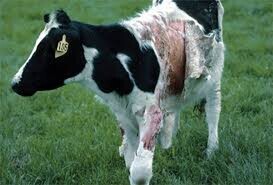Facial Eczema (FE) is a disease caused by a fungus that grows on the grass. The fungus produces spores in warm and humid conditions (ie January to May), which release a toxin that causes liver damage when eaten by cows. The liver is then unable to metabolise chlorophyll in grass properly - these un-processed particles then react with sunlight to cause skin inflammation and overt disease.
However, these clinical cases of swollen and sloughing skin only represent 5% of affected animals - if only one cow in your herd is visibly affected, it is likely that every other member has been exposed and their production compromised. High level or chronic low level exposure compounds the liver damage, impacting its ability to function properly over the cow’s entire lifetime, not just during one facial eczema season.
A recent study from the Facial Eczema Action Group found that FE can cost individual farmers more than $100,000 a year through lost milk production alone. Even small changes to how you prevent and manage the disease could make a substantial improvement to productivity and animal health and well-being.
As there is no cure, the use of preventative zinc and monitoring spore counts is the main way to manage FE. Zinc prevents the buildup of chlorophyll breakdown products and is usually given as an intra-ruminal bolus (Faceguard). It can also be drenched, dusted on pasture or given in-water or in-feed. The spores are found at the base of the sward, so avoiding hard grazing below 4cm will decrease the amount of toxin ingested. The use of pasture fungicides to eliminate spores or alternative pastures with less dead litter (chicory, clovers) may also help.
FE resistance can also be hereditary and farmers are reporting benefits from selective breeding.
There is considerable variability in spore counts between farms and even paddocks, so when regional counts start to rise, it's advisable to start checking your own pasture samples - don’t make decisions based on someone else’s farm. Choose 4 different paddocks and sample repeatedly throughout the high-risk period, or take from the next paddock to be grazed. Any count greater than 15,000 spores/g is considered a risk - supplementation is essential when spores reach over 30,000 and should be continued until counts drop to below 10,000 for several weeks. Trials in 2014 showed that around 70% of cattle don’t have enough zinc to protect against FE - consider blood testing to check the efficacy of your zinc supplementation.
And remember that facial eczema also affects sheep, so if you have any lawn mowers, they’ll need protection too.

